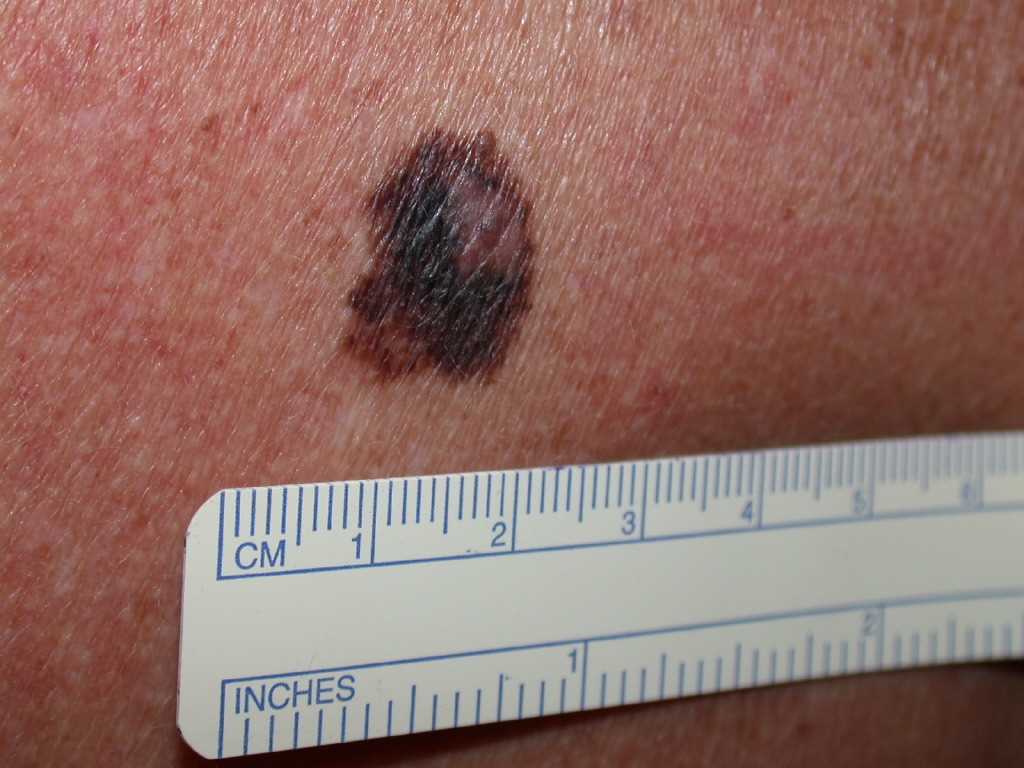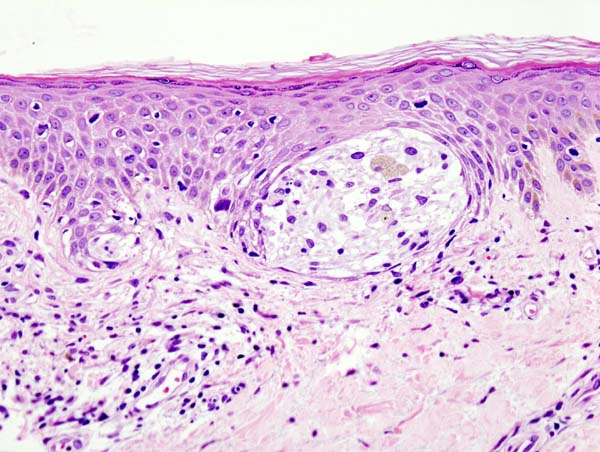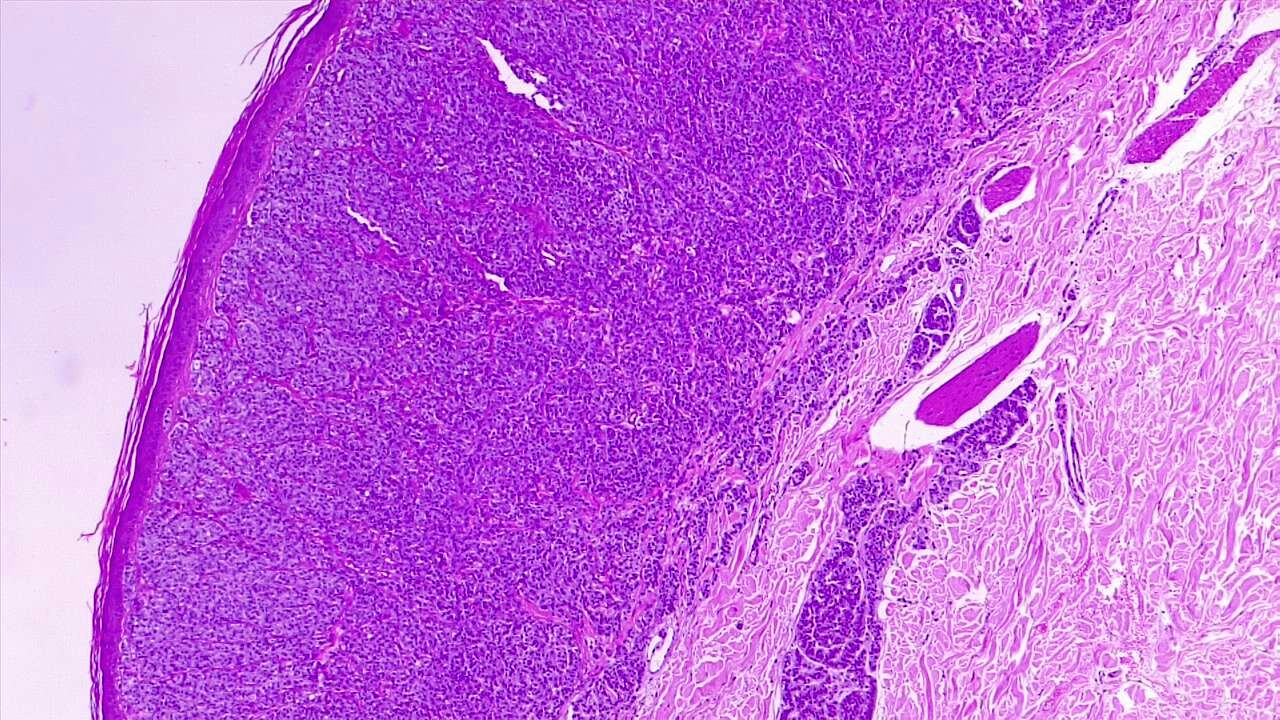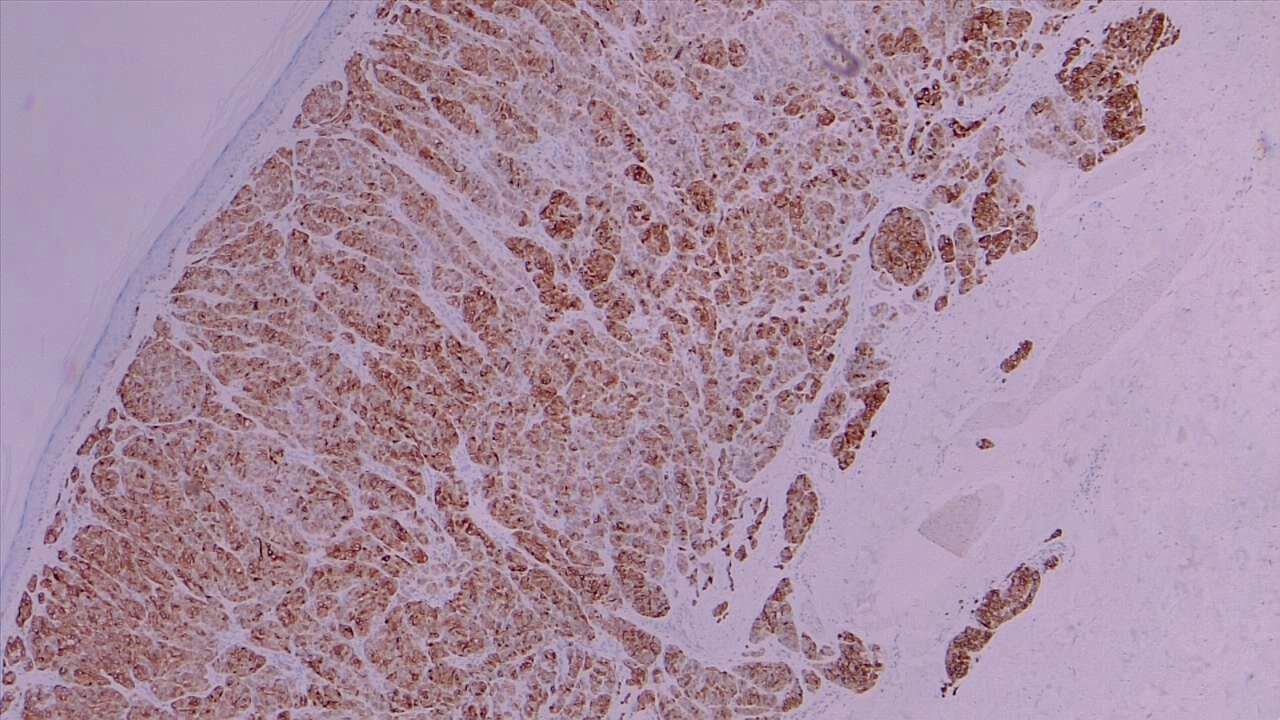[1]
Siegel RL, Miller KD, Wagle NS, Jemal A. Cancer statistics, 2023. CA: a cancer journal for clinicians. 2023 Jan:73(1):17-48. doi: 10.3322/caac.21763. Epub
[PubMed PMID: 36633525]
[2]
Wong VK, Lubner MG, Menias CO, Mellnick VM, Kennedy TA, Bhalla S, Pickhardt PJ. Clinical and Imaging Features of Noncutaneous Melanoma. AJR. American journal of roentgenology. 2017 May:208(5):942-959. doi: 10.2214/AJR.16.16800. Epub 2017 Mar 16
[PubMed PMID: 28301211]
[3]
Faries MB, Thompson JF, Cochran AJ, Andtbacka RH, Mozzillo N, Zager JS, Jahkola T, Bowles TL, Testori A, Beitsch PD, Hoekstra HJ, Moncrieff M, Ingvar C, Wouters MWJM, Sabel MS, Levine EA, Agnese D, Henderson M, Dummer R, Rossi CR, Neves RI, Trocha SD, Wright F, Byrd DR, Matter M, Hsueh E, MacKenzie-Ross A, Johnson DB, Terheyden P, Berger AC, Huston TL, Wayne JD, Smithers BM, Neuman HB, Schneebaum S, Gershenwald JE, Ariyan CE, Desai DC, Jacobs L, McMasters KM, Gesierich A, Hersey P, Bines SD, Kane JM, Barth RJ, McKinnon G, Farma JM, Schultz E, Vidal-Sicart S, Hoefer RA, Lewis JM, Scheri R, Kelley MC, Nieweg OE, Noyes RD, Hoon DSB, Wang HJ, Elashoff DA, Elashoff RM. Completion Dissection or Observation for Sentinel-Node Metastasis in Melanoma. The New England journal of medicine. 2017 Jun 8:376(23):2211-2222. doi: 10.1056/NEJMoa1613210. Epub
[PubMed PMID: 28591523]
[4]
MacKie RM, Reid R, Junor B. Fatal melanoma transferred in a donated kidney 16 years after melanoma surgery. The New England journal of medicine. 2003 Feb 6:348(6):567-8
[PubMed PMID: 12571271]
[5]
Crombie IK. Variation of melanoma incidence with latitude in North America and Europe. British journal of cancer. 1979 Nov:40(5):774-81
[PubMed PMID: 508580]
[6]
Motofei IG. Malignant Melanoma: Autoimmunity and Supracellular Messaging as New Therapeutic Approaches. Current treatment options in oncology. 2019 May 6:20(6):45. doi: 10.1007/s11864-019-0643-4. Epub 2019 May 6
[PubMed PMID: 31056729]
[7]
Motofei IG. Melanoma and autoimmunity: spontaneous regressions as a possible model for new therapeutic approaches. Melanoma research. 2019 Jun:29(3):231-236. doi: 10.1097/CMR.0000000000000573. Epub
[PubMed PMID: 30615013]
[8]
Byrne EH, Fisher DE. Immune and molecular correlates in melanoma treated with immune checkpoint blockade. Cancer. 2017 Jun 1:123(S11):2143-2153. doi: 10.1002/cncr.30444. Epub
[PubMed PMID: 28543699]
[9]
Soufir N, Avril MF, Chompret A, Demenais F, Bombled J, Spatz A, Stoppa-Lyonnet D, Bénard J, Bressac-de Paillerets B. Prevalence of p16 and CDK4 germline mutations in 48 melanoma-prone families in France. The French Familial Melanoma Study Group. Human molecular genetics. 1998 Feb:7(2):209-16
[PubMed PMID: 9425228]
[10]
Puntervoll HE, Yang XR, Vetti HH, Bachmann IM, Avril MF, Benfodda M, Catricalà C, Dalle S, Duval-Modeste AB, Ghiorzo P, Grammatico P, Harland M, Hayward NK, Hu HH, Jouary T, Martin-Denavit T, Ozola A, Palmer JM, Pastorino L, Pjanova D, Soufir N, Steine SJ, Stratigos AJ, Thomas L, Tinat J, Tsao H, Veinalde R, Tucker MA, Bressac-de Paillerets B, Newton-Bishop JA, Goldstein AM, Akslen LA, Molven A. Melanoma prone families with CDK4 germline mutation: phenotypic profile and associations with MC1R variants. Journal of medical genetics. 2013 Apr:50(4):264-70. doi: 10.1136/jmedgenet-2012-101455. Epub 2013 Feb 5
[PubMed PMID: 23384855]
[11]
Zuo L, Weger J, Yang Q, Goldstein AM, Tucker MA, Walker GJ, Hayward N, Dracopoli NC. Germline mutations in the p16INK4a binding domain of CDK4 in familial melanoma. Nature genetics. 1996 Jan:12(1):97-9
[PubMed PMID: 8528263]
[12]
Kamb A, Shattuck-Eidens D, Eeles R, Liu Q, Gruis NA, Ding W, Hussey C, Tran T, Miki Y, Weaver-Feldhaus J. Analysis of the p16 gene (CDKN2) as a candidate for the chromosome 9p melanoma susceptibility locus. Nature genetics. 1994 Sep:8(1):23-6
[PubMed PMID: 7987388]
[13]
Prota G, d'Ischia M, Mascagna D. Melanogenesis as a targeting strategy against metastatic melanoma: a reassessment. Melanoma research. 1994 Dec:4(6):351-8
[PubMed PMID: 7703714]
[14]
Rastrelli M, Tropea S, Rossi CR, Alaibac M. Melanoma: epidemiology, risk factors, pathogenesis, diagnosis and classification. In vivo (Athens, Greece). 2014 Nov-Dec:28(6):1005-11
[PubMed PMID: 25398793]
[15]
Gandini S, Autier P, Boniol M. Reviews on sun exposure and artificial light and melanoma. Progress in biophysics and molecular biology. 2011 Dec:107(3):362-6. doi: 10.1016/j.pbiomolbio.2011.09.011. Epub 2011 Sep 19
[PubMed PMID: 21958910]
[16]
Vosmík F. [Malignant melanoma of the skin. Epidemiology, risk factors, clinical diagnosis]. Casopis lekaru ceskych. 1996 Jul 26:135(13):405-8
[PubMed PMID: 8925536]
[17]
Lejeune FJ. Epidemiology and etiology of malignant melanoma. Biomedicine & pharmacotherapy = Biomedecine & pharmacotherapie. 1986:40(3):91-9
[PubMed PMID: 3527290]
[18]
O'Neill CH, Scoggins CR. Melanoma. Journal of surgical oncology. 2019 Oct:120(5):873-881. doi: 10.1002/jso.25604. Epub 2019 Jun 27
[PubMed PMID: 31246291]
[19]
Uhara H. Recent advances in therapeutic strategies for unresectable or metastatic melanoma and real-world data in Japan. International journal of clinical oncology. 2019 Dec:24(12):1508-1514. doi: 10.1007/s10147-018-1246-y. Epub 2018 Feb 22
[PubMed PMID: 29470725]
Level 3 (low-level) evidence
[20]
Curtin JA, Fridlyand J, Kageshita T, Patel HN, Busam KJ, Kutzner H, Cho KH, Aiba S, Bröcker EB, LeBoit PE, Pinkel D, Bastian BC. Distinct sets of genetic alterations in melanoma. The New England journal of medicine. 2005 Nov 17:353(20):2135-47
[PubMed PMID: 16291983]
[21]
Poynter JN, Elder JT, Fullen DR, Nair RP, Soengas MS, Johnson TM, Redman B, Thomas NE, Gruber SB. BRAF and NRAS mutations in melanoma and melanocytic nevi. Melanoma research. 2006 Aug:16(4):267-73
[PubMed PMID: 16845322]
[22]
Elder DE, Bastian BC, Cree IA, Massi D, Scolyer RA. The 2018 World Health Organization Classification of Cutaneous, Mucosal, and Uveal Melanoma: Detailed Analysis of 9 Distinct Subtypes Defined by Their Evolutionary Pathway. Archives of pathology & laboratory medicine. 2020 Apr:144(4):500-522. doi: 10.5858/arpa.2019-0561-RA. Epub 2020 Feb 14
[PubMed PMID: 32057276]
[23]
Friedman RJ, Rigel DS, Kopf AW, Lieblich L, Lew R, Harris MN, Roses DF, Gumport SL, Ragaz A, Waldo E, Levine J, Levenstein M, Koenig R, Bart RS, Trau H. Favorable prognosis for malignant melanomas associated with acquired melanocytic nevi. Archives of dermatology. 1983 Jun:119(6):455-62
[PubMed PMID: 6859885]
[24]
Smoller BR. Histologic criteria for diagnosing primary cutaneous malignant melanoma. Modern pathology : an official journal of the United States and Canadian Academy of Pathology, Inc. 2006 Feb:19 Suppl 2():S34-40
[PubMed PMID: 16446714]
[25]
Abbasi NR, Shaw HM, Rigel DS, Friedman RJ, McCarthy WH, Osman I, Kopf AW, Polsky D. Early diagnosis of cutaneous melanoma: revisiting the ABCD criteria. JAMA. 2004 Dec 8:292(22):2771-6
[PubMed PMID: 15585738]
[26]
Daniel Jensen J, Elewski BE. The ABCDEF Rule: Combining the "ABCDE Rule" and the "Ugly Duckling Sign" in an Effort to Improve Patient Self-Screening Examinations. The Journal of clinical and aesthetic dermatology. 2015 Feb:8(2):15
[PubMed PMID: 25741397]
[27]
Holmes GA, Vassantachart JM, Limone BA, Zumwalt M, Hirokane J, Jacob SE. Using Dermoscopy to Identify Melanoma and Improve Diagnostic Discrimination. Federal practitioner : for the health care professionals of the VA, DoD, and PHS. 2018 May:35(Suppl 4):S39-S45
[PubMed PMID: 30766399]
[28]
Gershenwald JE, Scolyer RA, Hess KR, Sondak VK, Long GV, Ross MI, Lazar AJ, Faries MB, Kirkwood JM, McArthur GA, Haydu LE, Eggermont AMM, Flaherty KT, Balch CM, Thompson JF, for members of the American Joint Committee on Cancer Melanoma Expert Panel and the International Melanoma Database and Discovery Platform. Melanoma staging: Evidence-based changes in the American Joint Committee on Cancer eighth edition cancer staging manual. CA: a cancer journal for clinicians. 2017 Nov:67(6):472-492. doi: 10.3322/caac.21409. Epub 2017 Oct 13
[PubMed PMID: 29028110]
[29]
Hayek SA, Munoz A, Dove JT, Hunsinger M, Arora T, Wild J, Shabahang M, Blansfield J. Hospital-Based Study of Compliance with NCCN Guidelines and Predictive Factors of Sentinel Lymph Node Biopsy in the Setting of Thin Melanoma Using the National Cancer Database. The American surgeon. 2018 May 1:84(5):672-679
[PubMed PMID: 29966567]
[30]
Janz TA, Neskey DM, Nguyen SA, Lentsch EJ. Is imaging of the brain necessary at diagnosis for cutaneous head and neck melanomas? American journal of otolaryngology. 2018 Sep-Oct:39(5):631-635. doi: 10.1016/j.amjoto.2018.06.007. Epub 2018 Jun 8
[PubMed PMID: 29929862]
[31]
Barker CA, Salama AK. New NCCN Guidelines for Uveal Melanoma and Treatment of Recurrent or Progressive Distant Metastatic Melanoma. Journal of the National Comprehensive Cancer Network : JNCCN. 2018 May:16(5S):646-650. doi: 10.6004/jnccn.2018.0042. Epub
[PubMed PMID: 29784747]
[32]
Reserva J, Janeczek M, Joyce C, Goslawski A, Hong H, Yuan FN, Balasubramanian N, Winterfield L, Swan J, Tung R. A Retrospective Analysis of Surveillance Adherence of Patients after Treatment of Primary Cutaneous Melanoma. The Journal of clinical and aesthetic dermatology. 2017 Dec:10(12):44-48
[PubMed PMID: 29399266]
Level 2 (mid-level) evidence
[33]
Blakely AM, Comissiong DS, Vezeridis MP, Miner TJ. Suboptimal Compliance With National Comprehensive Cancer Network Melanoma Guidelines: Who Is at Risk? American journal of clinical oncology. 2018 Aug:41(8):754-759. doi: 10.1097/COC.0000000000000362. Epub
[PubMed PMID: 28121641]
[34]
Coit DG, Thompson JA, Algazi A, Andtbacka R, Bichakjian CK, Carson WE 3rd, Daniels GA, DiMaio D, Fields RC, Fleming MD, Gastman B, Gonzalez R, Guild V, Johnson D, Joseph RW, Lange JR, Martini MC, Materin MA, Olszanski AJ, Ott P, Gupta AP, Ross MI, Salama AK, Skitzki J, Swetter SM, Tanabe KK, Torres-Roca JF, Trisal V, Urist MM, McMillian N, Engh A. NCCN Guidelines Insights: Melanoma, Version 3.2016. Journal of the National Comprehensive Cancer Network : JNCCN. 2016 Aug:14(8):945-58
[PubMed PMID: 27496110]
[35]
Coit DG, Thompson JA, Algazi A, Andtbacka R, Bichakjian CK, Carson WE 3rd, Daniels GA, DiMaio D, Ernstoff M, Fields RC, Fleming MD, Gonzalez R, Guild V, Halpern AC, Hodi FS Jr, Joseph RW, Lange JR, Martini MC, Materin MA, Olszanski AJ, Ross MI, Salama AK, Skitzki J, Sosman J, Swetter SM, Tanabe KK, Torres-Roca JF, Trisal V, Urist MM, McMillian N, Engh A. Melanoma, Version 2.2016, NCCN Clinical Practice Guidelines in Oncology. Journal of the National Comprehensive Cancer Network : JNCCN. 2016 Apr:14(4):450-73
[PubMed PMID: 27059193]
Level 1 (high-level) evidence
[36]
Cascinelli N. Margin of resection in the management of primary melanoma. Seminars in surgical oncology. 1998 Jun:14(4):272-5
[PubMed PMID: 9588719]
[37]
Cohn-Cedermark G, Rutqvist LE, Andersson R, Breivald M, Ingvar C, Johansson H, Jönsson PE, Krysander L, Lindholm C, Ringborg U. Long term results of a randomized study by the Swedish Melanoma Study Group on 2-cm versus 5-cm resection margins for patients with cutaneous melanoma with a tumor thickness of 0.8-2.0 mm. Cancer. 2000 Oct 1:89(7):1495-501
[PubMed PMID: 11013363]
Level 1 (high-level) evidence
[38]
Khayat D, Rixe O, Martin G, Soubrane C, Banzet M, Bazex JA, Lauret P, Vérola O, Auclerc G, Harper P, Banzet P, French Group of Research on Malignant Melanoma. Surgical margins in cutaneous melanoma (2 cm versus 5 cm for lesions measuring less than 2.1-mm thick). Cancer. 2003 Apr 15:97(8):1941-6
[PubMed PMID: 12673721]
[39]
Karakousis CP, Balch CM, Urist MM, Ross MM, Smith TJ, Bartolucci AA. Local recurrence in malignant melanoma: long-term results of the multiinstitutional randomized surgical trial. Annals of surgical oncology. 1996 Sep:3(5):446-52
[PubMed PMID: 8876886]
Level 1 (high-level) evidence
[40]
Thomas JM, Newton-Bishop J, A'Hern R, Coombes G, Timmons M, Evans J, Cook M, Theaker J, Fallowfield M, O'Neill T, Ruka W, Bliss JM, United Kingdom Melanoma Study Group, British Association of Plastic Surgeons, Scottish Cancer Therapy Network. Excision margins in high-risk malignant melanoma. The New England journal of medicine. 2004 Feb 19:350(8):757-66
[PubMed PMID: 14973217]
[41]
Gillgren P, Drzewiecki KT, Niin M, Gullestad HP, Hellborg H, Månsson-Brahme E, Ingvar C, Ringborg U. 2-cm versus 4-cm surgical excision margins for primary cutaneous melanoma thicker than 2 mm: a randomised, multicentre trial. Lancet (London, England). 2011 Nov 5:378(9803):1635-42. doi: 10.1016/S0140-6736(11)61546-8. Epub 2011 Oct 23
[PubMed PMID: 22027547]
Level 1 (high-level) evidence
[42]
Utjés D, Malmstedt J, Teras J, Drzewiecki K, Gullestad HP, Ingvar C, Eriksson H, Gillgren P. 2-cm versus 4-cm surgical excision margins for primary cutaneous melanoma thicker than 2 mm: long-term follow-up of a multicentre, randomised trial. Lancet (London, England). 2019 Aug 10:394(10197):471-477. doi: 10.1016/S0140-6736(19)31132-8. Epub 2019 Jul 4
[PubMed PMID: 31280965]
Level 1 (high-level) evidence
[43]
Finley RK 3rd, Driscoll DL, Blumenson LE, Karakousis CP. Subungual melanoma: an eighteen-year review. Surgery. 1994 Jul:116(1):96-100
[PubMed PMID: 8023276]
[44]
Morton DL, Thompson JF, Cochran AJ, Mozzillo N, Elashoff R, Essner R, Nieweg OE, Roses DF, Hoekstra HJ, Karakousis CP, Reintgen DS, Coventry BJ, Glass EC, Wang HJ, MSLT Group. Sentinel-node biopsy or nodal observation in melanoma. The New England journal of medicine. 2006 Sep 28:355(13):1307-17
[PubMed PMID: 17005948]
[45]
Morton DL, Thompson JF, Cochran AJ, Mozzillo N, Nieweg OE, Roses DF, Hoekstra HJ, Karakousis CP, Puleo CA, Coventry BJ, Kashani-Sabet M, Smithers BM, Paul E, Kraybill WG, McKinnon JG, Wang HJ, Elashoff R, Faries MB, MSLT Group. Final trial report of sentinel-node biopsy versus nodal observation in melanoma. The New England journal of medicine. 2014 Feb 13:370(7):599-609. doi: 10.1056/NEJMoa1310460. Epub
[PubMed PMID: 24521106]
[46]
Luke JJ, Rutkowski P, Queirolo P, Del Vecchio M, Mackiewicz J, Chiarion-Sileni V, de la Cruz Merino L, Khattak MA, Schadendorf D, Long GV, Ascierto PA, Mandala M, De Galitiis F, Haydon A, Dummer R, Grob JJ, Robert C, Carlino MS, Mohr P, Poklepovic A, Sondak VK, Scolyer RA, Kirkwood JM, Chen K, Diede SJ, Ahsan S, Ibrahim N, Eggermont AMM, KEYNOTE-716 Investigators. Pembrolizumab versus placebo as adjuvant therapy in completely resected stage IIB or IIC melanoma (KEYNOTE-716): a randomised, double-blind, phase 3 trial. Lancet (London, England). 2022 Apr 30:399(10336):1718-1729. doi: 10.1016/S0140-6736(22)00562-1. Epub 2022 Apr 1
[PubMed PMID: 35367007]
Level 1 (high-level) evidence
[47]
Long GV, Luke JJ, Khattak MA, de la Cruz Merino L, Del Vecchio M, Rutkowski P, Spagnolo F, Mackiewicz J, Chiarion-Sileni V, Kirkwood JM, Robert C, Grob JJ, de Galitiis F, Schadendorf D, Carlino MS, Mohr P, Dummer R, Gershenwald JE, Yoon CH, Wu XL, Fukunaga-Kalabis M, Krepler C, Eggermont AMM, Ascierto PA, KEYNOTE-716 Investigators. Pembrolizumab versus placebo as adjuvant therapy in resected stage IIB or IIC melanoma (KEYNOTE-716): distant metastasis-free survival results of a multicentre, double-blind, randomised, phase 3 trial. The Lancet. Oncology. 2022 Nov:23(11):1378-1388. doi: 10.1016/S1470-2045(22)00559-9. Epub 2022 Oct 18
[PubMed PMID: 36265502]
Level 1 (high-level) evidence
[48]
Garbe C, Keim U, Suciu S, Amaral T, Eigentler TK, Gesierich A, Hauschild A, Heinzerling L, Kiecker F, Schadendorf D, Stadler R, Sunderkötter C, Tüting T, Utikal J, Wollina U, Zouboulis CC, Keilholz U, Testori A, Martus P, Leiter U, Eggermont AMM, German Central Malignant Melanoma Registry and the European Organisation for Research and Treatment of Cancer. Prognosis of Patients With Stage III Melanoma According to American Joint Committee on Cancer Version 8: A Reassessment on the Basis of 3 Independent Stage III Melanoma Cohorts. Journal of clinical oncology : official journal of the American Society of Clinical Oncology. 2020 Aug 1:38(22):2543-2551. doi: 10.1200/JCO.19.03034. Epub 2020 Jun 12
[PubMed PMID: 32530760]
[49]
Moncrieff MD, Lo SN, Scolyer RA, Heaton MJ, Nobes JP, Snelling AP, Carr MJ, Nessim C, Wade R, Peach AH, Kisyova R, Mason J, Wilson ED, Nolan G, Pritchard Jones R, Johansson I, Olofsson Bagge R, Wright LJ, Patel NG, Sondak VK, Thompson JF, Zager JS. Clinical Outcomes and Risk Stratification of Early-Stage Melanoma Micrometastases From an International Multicenter Study: Implications for the Management of American Joint Committee on Cancer IIIA Disease. Journal of clinical oncology : official journal of the American Society of Clinical Oncology. 2022 Dec 1:40(34):3940-3951. doi: 10.1200/JCO.21.02488. Epub 2022 Jul 18
[PubMed PMID: 35849790]
Level 2 (mid-level) evidence
[50]
Weber J, Mandala M, Del Vecchio M, Gogas HJ, Arance AM, Cowey CL, Dalle S, Schenker M, Chiarion-Sileni V, Marquez-Rodas I, Grob JJ, Butler MO, Middleton MR, Maio M, Atkinson V, Queirolo P, Gonzalez R, Kudchadkar RR, Smylie M, Meyer N, Mortier L, Atkins MB, Long GV, Bhatia S, Lebbé C, Rutkowski P, Yokota K, Yamazaki N, Kim TM, de Pril V, Sabater J, Qureshi A, Larkin J, Ascierto PA, CheckMate 238 Collaborators. Adjuvant Nivolumab versus Ipilimumab in Resected Stage III or IV Melanoma. The New England journal of medicine. 2017 Nov 9:377(19):1824-1835. doi: 10.1056/NEJMoa1709030. Epub 2017 Sep 10
[PubMed PMID: 28891423]
[51]
Dummer R, Hauschild A, Santinami M, Atkinson V, Mandalà M, Kirkwood JM, Chiarion Sileni V, Larkin J, Nyakas M, Dutriaux C, Haydon A, Robert C, Mortier L, Schachter J, Lesimple T, Plummer R, Dasgupta K, Gasal E, Tan M, Long GV, Schadendorf D. Five-Year Analysis of Adjuvant Dabrafenib plus Trametinib in Stage III Melanoma. The New England journal of medicine. 2020 Sep 17:383(12):1139-1148. doi: 10.1056/NEJMoa2005493. Epub 2020 Sep 2
[PubMed PMID: 32877599]
[52]
Eggermont AMM, Blank CU, Mandala M, Long GV, Atkinson V, Dalle S, Haydon A, Lichinitser M, Khattak A, Carlino MS, Sandhu S, Larkin J, Puig S, Ascierto PA, Rutkowski P, Schadendorf D, Koornstra R, Hernandez-Aya L, Maio M, van den Eertwegh AJM, Grob JJ, Gutzmer R, Jamal R, Lorigan P, Ibrahim N, Marreaud S, van Akkooi ACJ, Suciu S, Robert C. Adjuvant Pembrolizumab versus Placebo in Resected Stage III Melanoma. The New England journal of medicine. 2018 May 10:378(19):1789-1801. doi: 10.1056/NEJMoa1802357. Epub 2018 Apr 15
[PubMed PMID: 29658430]
[53]
Burmeister BH, Henderson MA, Ainslie J, Fisher R, Di Iulio J, Smithers BM, Hong A, Shannon K, Scolyer RA, Carruthers S, Coventry BJ, Babington S, Duprat J, Hoekstra HJ, Thompson JF. Adjuvant radiotherapy versus observation alone for patients at risk of lymph-node field relapse after therapeutic lymphadenectomy for melanoma: a randomised trial. The Lancet. Oncology. 2012 Jun:13(6):589-97. doi: 10.1016/S1470-2045(12)70138-9. Epub 2012 May 9
[PubMed PMID: 22575589]
Level 1 (high-level) evidence
[54]
Henderson MA, Burmeister BH, Ainslie J, Fisher R, Di Iulio J, Smithers BM, Hong A, Shannon K, Scolyer RA, Carruthers S, Coventry BJ, Babington S, Duprat J, Hoekstra HJ, Thompson JF. Adjuvant lymph-node field radiotherapy versus observation only in patients with melanoma at high risk of further lymph-node field relapse after lymphadenectomy (ANZMTG 01.02/TROG 02.01): 6-year follow-up of a phase 3, randomised controlled trial. The Lancet. Oncology. 2015 Sep:16(9):1049-1060. doi: 10.1016/S1470-2045(15)00187-4. Epub 2015 Jul 20
[PubMed PMID: 26206146]
Level 1 (high-level) evidence
[55]
Patel SP, Othus M, Chen Y, Wright GP Jr, Yost KJ, Hyngstrom JR, Hu-Lieskovan S, Lao CD, Fecher LA, Truong TG, Eisenstein JL, Chandra S, Sosman JA, Kendra KL, Wu RC, Devoe CE, Deutsch GB, Hegde A, Khalil M, Mangla A, Reese AM, Ross MI, Poklepovic AS, Phan GQ, Onitilo AA, Yasar DG, Powers BC, Doolittle GC, In GK, Kokot N, Gibney GT, Atkins MB, Shaheen M, Warneke JA, Ikeguchi A, Najera JE, Chmielowski B, Crompton JG, Floyd JD, Hsueh E, Margolin KA, Chow WA, Grossmann KF, Dietrich E, Prieto VG, Lowe MC, Buchbinder EI, Kirkwood JM, Korde L, Moon J, Sharon E, Sondak VK, Ribas A. Neoadjuvant-Adjuvant or Adjuvant-Only Pembrolizumab in Advanced Melanoma. The New England journal of medicine. 2023 Mar 2:388(9):813-823. doi: 10.1056/NEJMoa2211437. Epub
[PubMed PMID: 36856617]
[56]
Reijers ILM, Menzies AM, van Akkooi ACJ, Versluis JM, van den Heuvel NMJ, Saw RPM, Pennington TE, Kapiteijn E, van der Veldt AAM, Suijkerbuijk KPM, Hospers GAP, Rozeman EA, Klop WMC, van Houdt WJ, Sikorska K, van der Hage JA, Grünhagen DJ, Wouters MW, Witkamp AJ, Zuur CL, Lijnsvelt JM, Torres Acosta A, Grijpink-Ongering LG, Gonzalez M, Jóźwiak K, Bierman C, Shannon KF, Ch'ng S, Colebatch AJ, Spillane AJ, Haanen JBAG, Rawson RV, van de Wiel BA, van de Poll-Franse LV, Scolyer RA, Boekhout AH, Long GV, Blank CU. Personalized response-directed surgery and adjuvant therapy after neoadjuvant ipilimumab and nivolumab in high-risk stage III melanoma: the PRADO trial. Nature medicine. 2022 Jun:28(6):1178-1188. doi: 10.1038/s41591-022-01851-x. Epub 2022 Jun 5
[PubMed PMID: 35661157]




